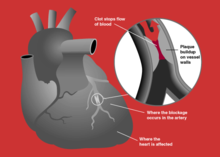First Aid/Heart Attack & Angina
Introduction — Issues in Providing Care — Primary Assessment & Basic Life Support — Secondary Assessment — Circulatory Emergencies
Respiratory Emergencies — Soft Tissue Injuries — Bone & Joint Injuries — Environmental Illness & Injury
Medical Conditions & Poisoning — Advanced Topics — Appendices — Meta content
Introduction[edit | edit source]

Heart attack (myocardial infarction) is when blood supply to the heart or part of the heart is cut off partially or completely, which leads to death of the heart muscle due to oxygen deprivation. Heart attacks usually occur after periods of rest or being recumbent, and only rarely occur after exercise (despite popular portrayal).
Angina (angina pectoris) is a 'miniature heart attack' caused by a short term blockage. Angina almost always occurs after strenuous exercise or periods of high stress for the victim.
The key differentiation between a heart attack and angina is that, in line with their typical onset modes, angina should start to relieve very shortly after resting (a few minutes), whereas a heart attack will not relieve with rest.
Pain in the chest can have many different causes and you should not attempt to distinguish between them. Always err on the side of caution and call for help when encountering a person with chest pain. This is absolutely crucial if the victim has had heart problems in the past.
Recognition[edit | edit source]
- Chest pain: tightness, pressure, or pain in the chest (often described as "crushing")
- Back pain: above or between the shoulder blades, often radiating into the left arm, and the jaw
- Nausea or indigestion (especially in women)
- Pale, cool, clammy skin
- Ashen grey skin
- Denial
- History of a similar episode earlier that "just went away"
While some people will show typical signs of a cardiac emergency, others will show none at all. This is especially true of women in general, and both men and women with diabetes.
Treatment[edit | edit source]
Call for assistance. A possible cardiac problem is serious, and should never be ignored or passed of as insignificant. Assist the victim with medication, only if it is prescribed to them. People with angina will often have medication to control it; either as pills or a spray. This medicine (nitroglycerin) is commonly referred to as “nitro”. The pills should never be touched with bare skin by the rescuer, as they will be absorbed directly through skin. These pills are placed directly under the tongue for absorption, never chewed or swallowed, and while the victim is seated. The spray should be taken on the bottom of the tongue, and should also be kept away from bare skin. Only the victim should administer his medication. This includes over the counter medications such as aspirin. Giving medication to someone in an emergency is much more complicated than handing the victim a pill, and should only be done by medical professionals. If he is unable to do so, then the rescuer should not do it for him. Helping to take the lid off or handing the bottle to the victim is acceptable. The names of the medications and times taken should be documented if the patient is transferred to other rescuers.
- Loosen tight clothing, especially around the neck to help the victim relax, and help medical personnel access the chest.
- Help the victim sit reclined, with the body leaned back at about 45 degrees, with feet on the floor, but knees raised – this puts the patient in a “W” position. Getting the victim comfortable without straining is more important than the position.
- Avoid giving food or drink which can complicate some treatments. If the victim complains of thirst, small sips of plain water or ice are acceptable.
- Be vigilant for any changes in condition which can occur rapidly and without warning.
- Be prepared to do CPR should the victim go into cardiac arrest.